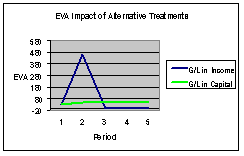Unrealized Gains and Losses
Unrealized gains are not recorded in GAAP financial statements. (The exception is businesses that manage exchange-traded asset portfolios. For such portfolios, mark-to-market accounting largely reflects the economics of the business). Unrealized losses are recorded for marketable securities or, sometimes, for inventory using the lower-of-cost-or-market (LCM) method.
Certain assets, however, generate little or no current revenue, and are held for their capacity to generate revenue in the future. Among these "non-producing" assets are vacant land or buildings, mineral rights, and patents. The only way to recognize the gains of these assets would be to sell them.
Recording certain unrealized losses but not any unrealized gains reflects accounting conservatism.
Economics of Depreciation
All assets are valuable based on both their current and future ability to generate cash. For assets whose cash generating ability is in the future, the market will build those future cash flows into the firms present value.Decisions about the use or disposal of non-revenue generating assets should always consider the assets current market value as its appropriate opportunity cost
Behavioral Impact
Unrealizedgains and losses create the potential for realizing gains and losses, which in turn create a matching problem. If management feels the need to boost accounting profits, an easy way to do so would be to sell assets that have significantly appreciated. While such sales are non-recurring, a firm with an inventory of such assets could periodically liquidate them to maintain its earnings.
Furthermore, if the assets are worth far more than their book value, the quality of the sale would not be easy to discern. The assets could be sold for below market and still realize substantial gains in booked profits.
Even if appreciated assets do not need to be sold, traditional accounting does not penalize management for not utilizing those assets to earn income, or, at best, for earning no more than a return on book value.
In extreme cases, management may be encouraged to speculate on assets with volatile values in order to inventory those that significantly appreciate for future disposal, essentially turning their operating business into a trading business.
Alternative Treatments
Recognizing unrealized gains and losses
Theoretically, every asset's value is different from its recorded cost. Income-producing assets provide a good indication of their market versus book value through transactions that result in EP.
For assets that don't produce revenue, the only way to record whether or not they are creating value would be to recognize their unrealized gain. For exchange-traded assets, such as securities or commodities, this is merely an information-processing task. For non-traded assets, we have an additional, and significant, valuation issue. Valuations of most non-traded assets can be expensive and inconclusive. When performance measurement becomes based on appraised values, the appraisal process itself becomes contentious and politicized.
While there are better ways than appraisals to obtain more objective valuations, these methods tend to be economical only for large, discrete assets. (Fortunately, numerous assets of fluctuating value tend to be traded more frequently, reducing the problems associated with unrealized gains.) Thus, infrequently traded or non-traded assets that can be valued can have their unrealized gains recognized.
Income or capital event?
If we decide to
recognize unrealized gains, we have a choice of how to recognize them,
either as income or as reductions to capital.
If the company is basically in the trading business, then any unrealized gains (or losses) should be recorded as income (loss) with capital stepped up accordingly. For all other businesses, where unrealized gains are an infrequent occurrence alongside recurring operating income, the gains (losses) should be subtracted from (added to) net assets so as to reduce (increase) capital. This would parallel the normally recommended treatment of realized gains or losses.
Ignoring appreciating assets
It may be appropriate to ignore appreciating assets altogether, including any gains or losses eventually realized on them. This is viable for assets that are completely removed from the core operations of the business.
For example, the owners of the business may have property inherited from the prior owner and no longer used by the business in any meaningful capacity. That property may have some value and may even generate a little income, but is otherwise completely out of the purview of operating management. Such "non-operating" assets can be separately assigned to the senior management of the company as its own EP center. Or, if the company is closely held and the ownership is so inclined, the assets can be excluded from anyone's area of responsibility within the company